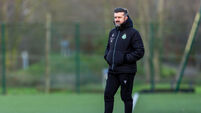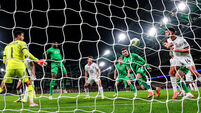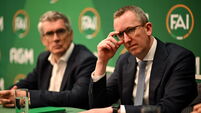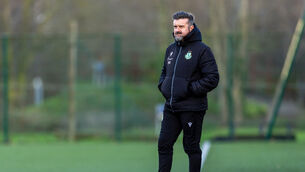Kieran Shannon: Why Ruud Dokter's 'elite player pathway' plan is not good for Irish football

Republic of Ireland manager Stephen Kenny and FAI High-Performance Director Ruud Dokter. Picture: INPHO/Laszlo Geczo
It’s hard to know what has been the more dispiriting for Irish football over the past month: the continuing inability of the senior men’s national team to carve out a goal or some of the action points in the latest talent development plan issued by Ruud Dokter.
In the end, the latter edges it, even if the former has commanded more headlines.
In case you may have missed it, the good Dokter, upon the appointment of Jonathan Hill as the new FAI chief executive that he’ll be reporting to, duly produced a 15-slide player development document in his own capacity as the sport’s high performance technical director.
The document claims its proposed “elite player pathway” is based on “best international practice” when actually almost all sports and international research suggests that the thrust of it is anything but.
As well as calling for the retention of the newly-formed U13 national league (along with similar leagues at U14, U15, U17, and U19), the document reveals that it is the “judgement of the FAI”, or at least Dokter’s, that 12 years of age — when every kid in this country is still only in primary school — is “an appropriate time for young talented players” to choose football as their primary sport.
GAA, rugby, basketball, or whatever else the child might like or be good at are already to be deemed secondary. With the kid having up to 400 minutes of club football a week between training and matches, any other sporting activities will be merely something to dabble at.
The document gives the veneer of being “player-centred” and consistent with best practice.
It states that it still “encourages” participation in other sports “on days when there is no club football training”.
It outlines the dangers of 12 and 13-year-olds playing at least two sports at an elite level: that it leaves little to no time for free play that allows the child to “express” him or herself, just as leaves little time for socialising with friends and family; that increases the risk of injury and of being pressurised by coaches when there’s an inevitable clash of fixtures.
But that’s purely a sleight of hand. Whoever suggested that any child at that age should be playing two sports at an “elite” level? Dokter is about the only person suggesting that a child that young should be participating in any form of “elite” sport.
And research as well as common sense shows that should they do so, they’re increasing their chances of injury, at least in the long run, that they’re limiting their time to socialise with friends that they might otherwise meet and play with down at their local GAA club, and that having to choose one sport over another at such a young age only increases instead of reduces the sense of pressure a child will feel from an adult supposedly entrusted with what’s best for their sporting and holistic development.
In advancing his case, Dokter cites a number of comparative statistics from countries inside the Fifa top 20 rankings, a place Ireland aspires to.
In advancing why your 12-year-old should be training three to four times a week with a Shelbourne or Cork City, he cites that U11s are already training that often from KSI Iceland to Barcelona, from Bayer Leverkussen to Inter Milan.
In Denmark clubs can sign for a professional club at 12 years of age. In Wales their academies start at 10 years of age. In Croatia, Belgium, Switzerland, Germany, and France they begin at eight years of age. In his native Holland, it’s at seven. In England, Spain, Portugal, and Iceland it’s six. In Scotland, professional clubs working with kids at as young as five.
What he neglects to mention is that just because something is standard international practice in football doesn’t mean it is best international practice. His paper is riddled with survivorship bias.
Mark Williams is considered one of the world’s leading researchers and authority on sports expertise and skill acquisition. Last month, in a collaboration with the Daily Telegraph’s Tim Wigmore, he brought out a highly-readable book called The Best: How Elite Athletes Are Made.
In it, he cites studies that show that in general early specialisers are twice as likely to pick up injuries due to overuse than those who play a range of sports.
“Later specialisation is also better for mental health,” Williams and Wigmore write. “Early specialisers are more likely to suffer burnout and quit their sport altogether, overwhelmed by the relentless focus upon one sport and the lack of equilibrium that comes when it becomes an all-consuming part of childhood.”
Although New Zealand is often cited as a rugby-first sporting nation, The Best outlines how that while rugby in that part of the world is an early-engagement sport, it is not an early-specialisation sport. Its athletes are encouraged to try out other sports, especially in rugby’s off-season.
As a rule of thumb, Williams advocates the three-stage model devised by Jean Cote, the prominent Canadian sports scientist. In order to give a child the best chance to succeed in a sport as well as what’s best for their emotional and physical wellbeing, they should sample as many sports as possible until their early adolescence; then focus on a few sports in their early and mid-teens; and then specialise in their mid-to-late teens.
There’s just one issue with Cote’s thesis: as Williams observes, “it assumes that sports participation is ethically grounded.” Professional football — the model which Dokter is basing much of his system from — is not necessarily ethically grounded.
Williams and Wigmore do stress that there are no hard and set rules in any of this. Context is vital. Some sports, like gymnastics, physiologically demand that there is early specialisation. And soccer, because it is such a mass participation and highly-technical sport, is not like a power-based, small-participation sport like rowing where someone can take up the sport in their 20s and win Olympic medals within five years.
But it is still not the early-specialisation sport that Dokter’s blueprint is advocating that it should be. Especially in a country like Ireland.
Since the passing of the great Jack Charlton, it has been regularly commented upon that he “got” the Irish. He understood we loved our craic and he understood we loved Gaelic Games as well. Once, while explaining his team’s style of play, he talked about how “it was more the sort of a game that they [the Irish] expected of their own Gaelic players —
you get the ball forward, you compete and chase people and close them down.”
Nowadays, most GAA teams methodically play through the lines, just like Stephen Kenny, and to be fair, Dokter himself, advocates, but the validity of Charlton’s observation remains. He watched Gaelic Games. He understood its place in the national psyche, that Kevin Moran played in and won All-Irelands.
The question has to be asked: does Dokter at this stage get the Irish? Does he even listen to them and his staff? Not once in his document does he mention the unique sporting landscape that he inhabits and that his new CEO may well be unfamiliar with: the letters G-A-A are never placed alongside one another.
Most of the current national team played GAA into their teens. And while they currently are not at the standard we’d like them to be, the question has to be asked: if John Egan at 12 years of age was forced to essentially quit GAA, would it have increased or decreased his desire and willingness to focus on soccer? If Dara O’Shea, who featured on Dublin development squads, was told he’d have to focus on soccer at 12, would he have obliged or told the FAI’s pathway where it could go?
Common sense would suggest that seven years is too long to expect a 12-year-old from west Clare to commute four times a week to train or play with a Galway United underage national league team. Somewhere along the way, they’re going to give up, they’re going to be lost to the game.
The research also shows it’s ultimately self-defeating. As Ross Tucker, the New Zealand sports scientist tells Williams and Wigmore, “At every stage where people identify talent they invariably shut the door behind them.”
The authors themselves recommend that sports governing bodies work together and agree not to put pressure on multi-sport athletes to specialise until they’re 14 or so in the best interests of the child — as they point out, later specialisation gives the child more chance of picking the sport that is the best fit for them — not one that suited their physical gifts when they were 12 or was forced upon them at the same age.
With the FAI and Dokter now willing to breach that pre-existing, unspoken collaborative arrangement, there is a case that not for the first time in the last 18 months that Sport Ireland should intervene or at least question whether it should be providing funding to a national governing body that is advocating and pursuing a policy that is fundamentally not child-centred and possibly damaging in the long run to the mental health of children.
The FAI’s performance director has done some good in his time here. But what the Dokter has just ordered is not what is best for his patient.









